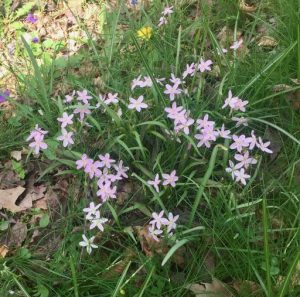A little story: A major event in my development as a gardener occurred when my mother cleared a tangle of rampant vines and other vegetation from the wooded part of our back yard, which backed onto Rock Creek Park. This might have been in 1964; when our family visited the New York World’s Fair, she had a terrible case of poison ivy from pulling vines and had to wear damp compresses on both forearms—maybe soaked in calamine lotion?
But it wasn’t the poison ivy that made the most lasting impression. It was what happened the spring after the big clear-out: spring beauties sparkled into bloom all over the wooded area, even into the lawn. This so delighted my mother that it inspired her to new heights of effort in the garden—despite the poison ivy, mosquitoes, heat, and other things that she as a transplant from England was not used to. I, too, was captivated. I found a Zen-like absorption in gently clearing grass and other competitors from around those delicate little flowers.

Spring beauties (Claytonia virginica) are only one of the many spring ephemerals native to our area. If our gardens have deciduous shade, we can also hope to grow trillium, bloodroot (Sanguinaria canadensis), dutchman’s breeches and squirrel corn (Dicentra cucullaria and D. canadensis), trout lily (Erythronium americanum), hepatica, and bleeding heart (Dicentra eximia)—all of which are spread by ants collecting and eating the eliaosomes on their seeds (see below). Other spring ephemerals may lack eliaosomes but are no less beloved, including Virginia bluebells (Mertensia virginica), mayapple (Podophyllum peltatum), twinleaf (Jeffersonia diphylla), rue anemone (Thalictrum thalictroides), and many others.
An elaiosome is a structure on some plant seeds that contains lipids and proteins that ants eat (see my article in November 2018 on our invertebrate garden friends). After taking seeds back to their nests, ants eat the elaiosome and discard the seed with other waste—ideal for germination. Some nonnative spring ephemerals also have eliaosomes, including snowdrops and some crocus species.
Because ants don’t travel great distances, most ant dispersal of seeds (myrmecochory) occurs relatively close to the parent plants.
Besides encouraging ants (or at least not killing them), another important thing we can do for our spring ephemerals is to leave the leaf litter so that it can turn into the rich humusy soil that these plants need. And of course, if you have any particularly precious specimens, you would be wise to mark them so you don’t disturb them later in the year.
As gardeners, of course, we also want to use later-emerging plants to fill in bare spots after the ephemerals have disappeared. Since some of them last longer than others and everyone’s conditions differ, this takes trial and error. I’ve had good results growing wild ginger (Asarum canadense) and Virginia bluebells together—and the bluebells self-seed, so you may find them popping up in other places. Ferns are useful companions for ephemerals, although you probably don’t want to use aggressive ones like sensitive fern or hay-scented fern. I’ve found that Christmas fern coexists well with other plants. Another suggestion I’ve seen, big-leaf aster (Eurybia macrophylla), is one I would love to use more. However, my few seed-grown plants are still too small and sparse to draw any conclusions (I live in hopes of observing its ability to spread).
To end with the story I started with: My mother isn’t the only person to discover that desirable native plants have been struggling along under an overgrowth of undesirables (whether invasive nonnatives or unwanted natives like poison ivy). One thing that conservation landscaping and habitat restoration work has found is that consistently removing competitive invasive plants is essential to allowing our natives to get established. So although I can’t guarantee that clearing out invasives will unleash a hidden population of desirable spring ephemerals or other natives, it can’t hurt, right?
—Barbara Collier